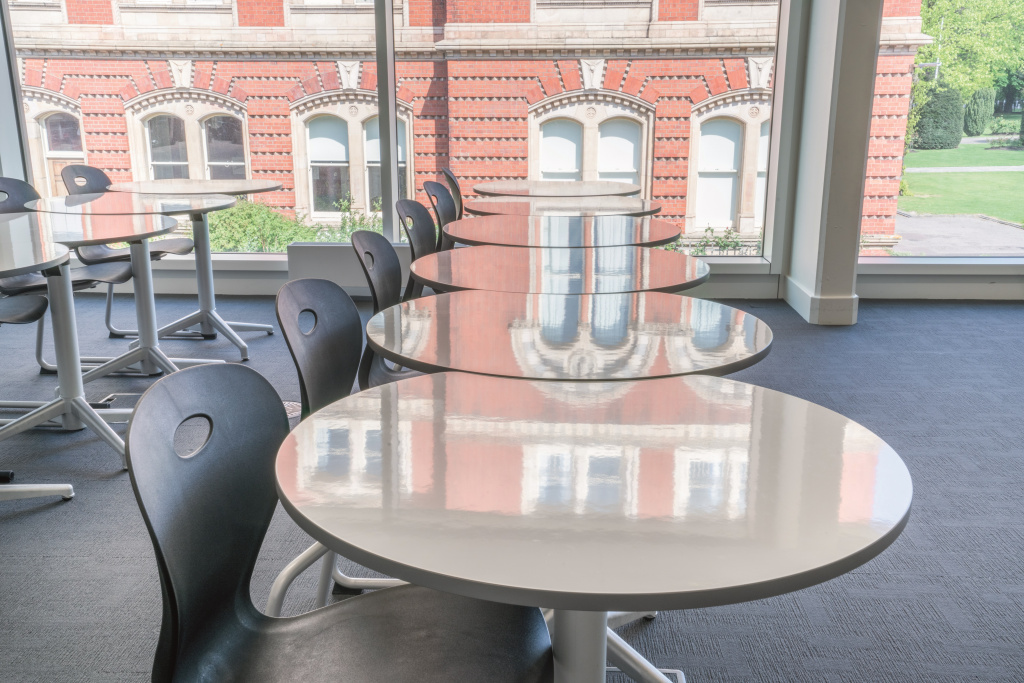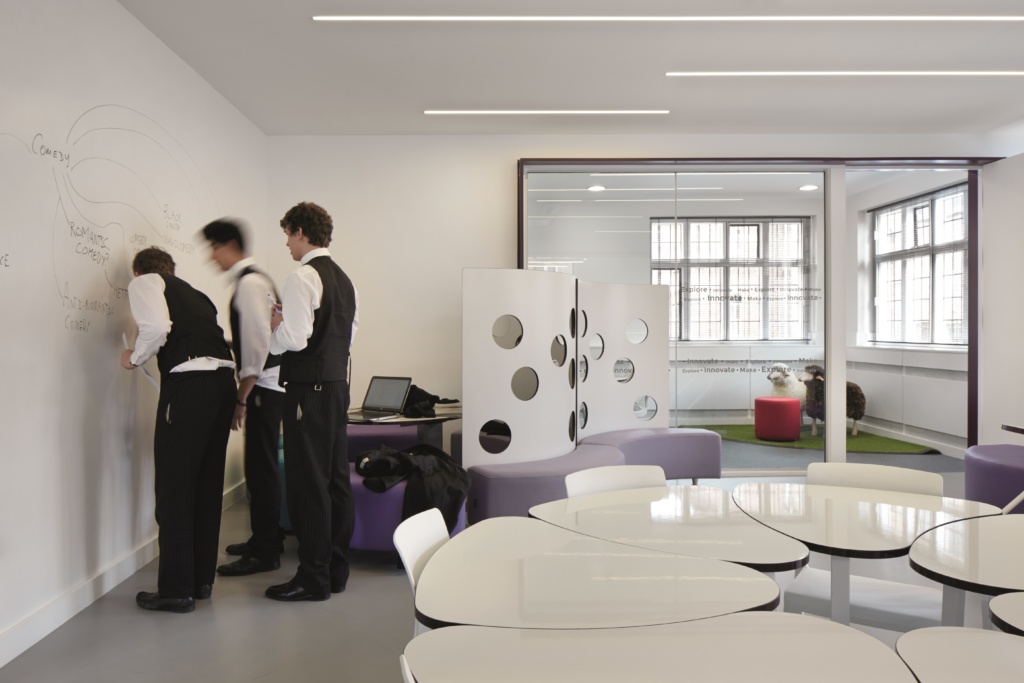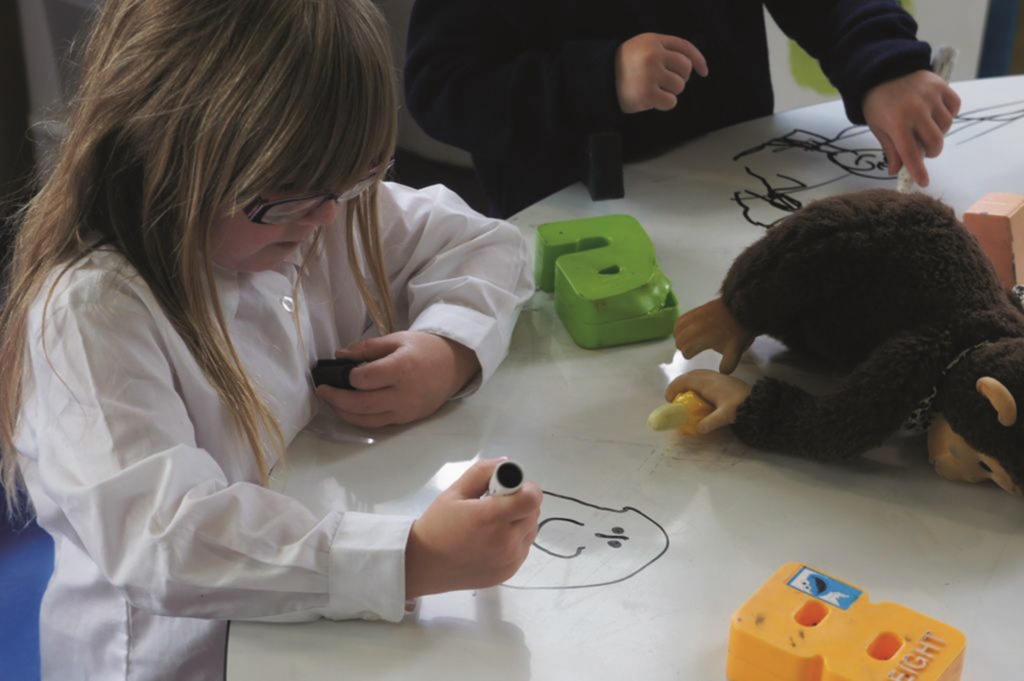
Is it that there’s something about the sense of audience: something about learners being on show that makes them work so well? Or is it that, now information technology is no longer in its infancy, that the novelty (so-to-speak) has worn off and we want to revert to the visceral, instinctive action of picking up a pen and making a physical mark on a surface? Whatever, it seems that dry-wipe surfaces are back, they’re here to stay and they now can be much much more sophisticated than the hand-held boards learners simultaneously held up to show the teacher their answer. “We know that when we ask learners to do presentation work, they do their best work” commented Juliette Heppell at London’s BETT in January, “so why wouldn’t we want all work to be like that?”. And if you think once students walk out of the learning space the work is lost – wiped off and gone for ever – then think again. With the camera on a mobile phone or tablet it’s recorded and can ultimately be uploaded to a digital portfolio.

Dry wipe surfaces typically fall into two formats – vertical (which we’d traditionally recognise as wall-mounted but which are now equally available as freestanding, mobile panels), and now horizontal (tables) too. There’s something about the physical space the learner takes up with vertical surfaces that puts a single person ‘in charge’ but horizontal surfaces absolutely change that dynamic: when you’re gathered around a table, a much more collaborative approach is evident, one where everyone participates on an equal footing.
But whilst it’s relatively easy to create an impromptu dry-wipe surface (pretty well any gloss surface will, to some extents, work) what is it about surfaces that make the best dry-wipe – ones that will remain stain-free for years – and which should you avoid at all costs? IKEA’s Lack gloss white coffee tables for example at, depending on where you live, kr59, US$14, A$20 or £8 (well it had to be cheapest in Sweden!) work perfectly well for a while, but in time they’d doubtless stain (although at that cost, arguably you could replace them). Nobody would claim that they’re designed, manufactured or advertised as dry-wipe, (it’s no more than a quirk of what was selected as an aesthetic treatment) and are manufactured using a gloss melamine foil – a material that just isn’t the most durable for a horizontal worksurface. In a learning space, they’ll inevitably have more than a coffee cup put on them, so it’s therefore unlikely they won’t, over time, get at least a little scuffed and scratched. For what they were originally designed for, this isn’t an issue – it’s simple aging. But when you’re then writing on them, it would represent a real problem.
What makes them, and many other gloss finishes stain (it’s frequently referred to as ghosting) is ink becoming trapped in the porosity of the surface. Even glass – one of the least porous of materials – will trap some ink in its surface (only much less so than a surface that is more so) to the extent it’s pretty well imperceptible to the naked eye. And it is this that makes glass, or alternatively vitreous enamel (the same chemical composition) when you judge them by performance alone, probably the best dry-wipe surfaces that are widely available. You’d like to think there were a series of formal standards for dry wipe surfaces to enable you to determine what’s good and what isn’t, but despite searching we could only find the 2010 European standard, EN 14434 and this we understand is being revised. But even with the best dry-wipe materials though, without an appropriate cleaning regime, the surface will deteriorate, and it has to be said that a piece of thick felt glued to a chunk of wood is, despite the popularity of the traditional board rubber to do the job, not the best way by far. Because over time the felt simply becomes impregnated with ink and it therefore becomes more of a case of redistribution than cleaning, with old ink being pushed around the surface, whilst it gets more and more ingrained into both the surface and the rubber. And whereas proprietary school supply catalogues boast that their liquid spray cleaners for dry wipe surfaces are ‘alcohol-free’ in truth, the ones with alcohol tend to give far superior results: the alcohol mixes with the ink and evaporates quickly out to the surface where it can be wiped away, preferably with something like a microfibre cloth (that should be regularly washed) or alternatively, although clearly not as environmentally friendly, with a disposable wet wipe. In all cases, what you’re trying to do is to remove the ink, and to keep whatever you’re cleaning it with, ink-free too.

Whilst there are some great glass vertical surfaces commercially available, the trouble with using glass as a table surface in learning environments is, and forgive the pun, clear to see: it’s vulnerable when it suffers impact, and if this did happen, the result inevitably carries significant danger. With vitreous enamel (the same chemical composition) on the other hand, the constraints lie around how the material is manufactured: finely powdered glass (frit) is fused to a metal (usually steel) substrate by firing. In the cases of mass-manufactured items (such as cooking utensils, baths etc) the steel ‘blank’ has been pre-fabricated to pre-determined sizes and profiles, but when if it was necessary to cut it (for example in furniture manufacture or if you wanted bespoke wall-boards to cover an entire wall) it’s practically impossible, economically, to do so without chipping the edges. Whilst these can be masked with an applied decorative edging, if your aim is for a whole wall, for example, any unavoidable joints have to be as inconspicuous as possible. Manufactures have experimented with laser cutting (the enamel melts) and water cutting (the steel rusts!) and as a consequence have instead looked to other materials.
When it comes to walls, IdeaPaint is probably the best known dry-erase coating, although Dulux’s DryErase™ paints are being used to great effect. And there are wallpapers as well such as Walltalkers WriteOn by Tektura. But both of these solutions rely on the smoothness of the wall to which they’re being applied. Especially with paint finishes, you’re fine if you have what plasterers refer to as a ‘perfect finish’ wall (Larry, our pet plasterer advised that it shouldn’t be ‘over-trowelled’ or the paint would have nothing to grip to) In practice though, value engineering in school builds means these are rarely now how partitions are finished in learning environments: the urban, industrial aesthetic of unpainted fair-faced breezeblocks has become a common architectural treatment, and these are about as far as you can get to an appropriate surface to paint or paper. In these instances you really have two choices. Call Larry in so once he’s done his stuff you can paint or paper the wall, or alternatively use a hung panel system. Spaceoasis’ LearningSurface® wall panels for example are manufactured from composite aluminium, are available in widths up to 2 metres wide or can be butted next to each other for a near-uninterrupted continuous run both indoors and outdoors.